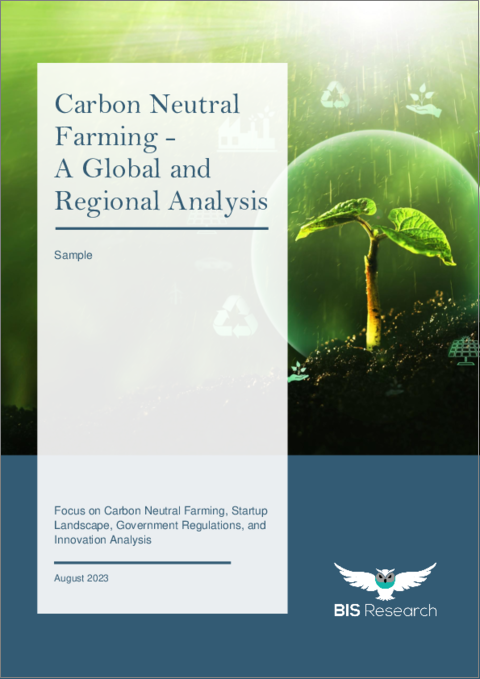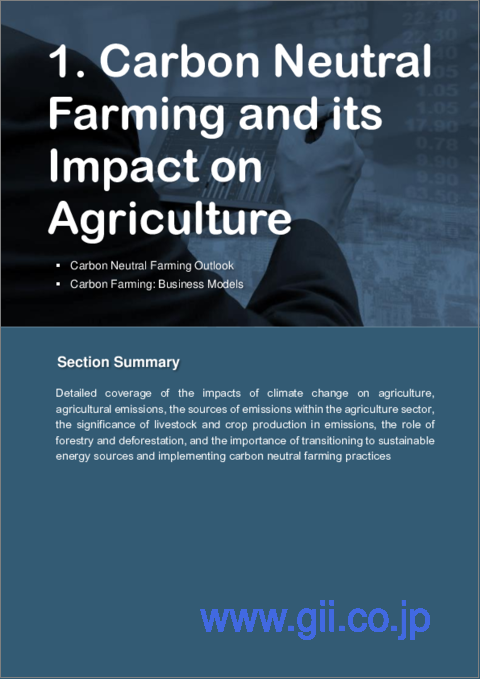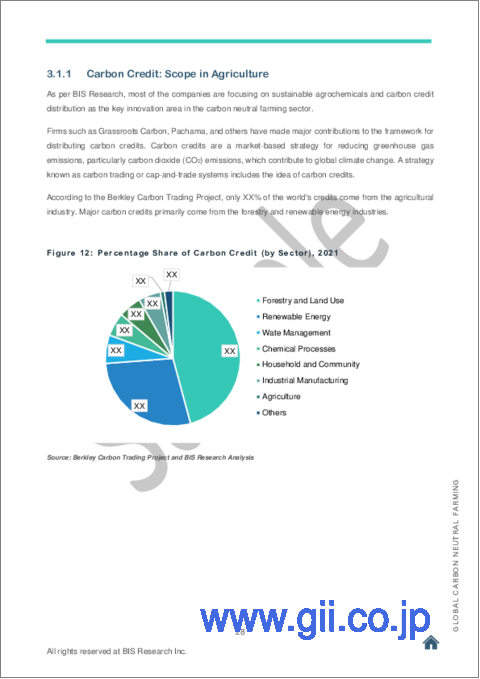|
|
市場調査レポート
商品コード
1344201
カーボンニュートラル農業の世界市場:カーボンニュートラル農業・新興企業の情勢・政府規制・イノベーションの分析Carbon Neutral Farming - A Global and Regional Analysis: Focus on Carbon Neutral Farming, Startup Landscape, Government Regulations, and Innovation Analysis |
||||||
カスタマイズ可能
|
|||||||
| カーボンニュートラル農業の世界市場:カーボンニュートラル農業・新興企業の情勢・政府規制・イノベーションの分析 |
|
出版日: 2023年08月28日
発行: BIS Research
ページ情報: 英文 85 Pages
納期: 1~5営業日
|
- 全表示
- 概要
- 図表
- 目次
カーボンニュートラル農業の導入は、新しい技術やインフラの導入に伴う多額の初期費用を伴うことが多いため、農家にとって経済的な課題となる可能性があります。
さらに、精密農業技術の導入には、専門的な設備やトレーニングへの投資が必要となります。しかし、このような初期の経済的障壁があるにもかかわらず、作物収量の増加や環境の持続可能性の向上といった長期的な利点があるため、カーボンニュートラル農業の採用を支援することは極めて重要です。
政府は、農家が持続可能で気候変動に強い農業に移行できるよう、必要な政策の枠組み、財政的インセンティブ、技術的支援を提供する上で重要な役割を担っています。政府は、カーボンニュートラル農業を積極的に推進・実施することで、気候変動の緩和と、農業と地球にとってより持続可能な未来の構築に大きく貢献します。世界のカーボンニュートラル農業を取り巻く規制状況は、国や地域によって異なっています。
当レポートでは、世界のカーボンニュートラル農業の市場を調査し、市場の定義と概要、炭素農業のビジネスモデル、地域および国別の規制の枠組み、スタートアップおよびイノベーションの情勢、ケーススタディ、各種提言などをまとめています。
目次
第1章 カーボンニュートラル農業とその農業への影響
- 見通し
- 市場の定義
- 炭素農業
- 炭素農業のビジネスモデル
- 行動ベースの炭素農業モデル
- 結果ベースの炭素農業モデル
- ハイブリッド炭素農業モデル
第2章 規制の枠組み
- 規制のリスト:地域および国レベル
- 北米
- 南米
- アジア太平洋
- 欧州
- 中東・アフリカ
- 英国
- 中国
第3章 スタートアップおよびイノベーションの情勢
- カーボンニュートラル農業におけるスタートアップの情勢
- 炭素クレジット:農業における展望
- 資金調達の情勢
- カーボンニュートラル農業における再生可能エネルギーの役割
- イノベーションエコシステム
- 持続可能な農薬
- スタートアップによるカーボンニュートラルプログラムと取り組み
- 炭素クレジットの分配モデル
- その他
第4章 ケーススタディ・導入成功のレビュー
- ケーススタディ・導入成功のレビュー
- ケーススタディ1-規制の導入
- ケーススタディ2-スタートアップのポジショニング
- ケーススタディ3-革新的技術
- ケーススタディ4-持続可能な製品
第5章 総論・提言
- 総論
- アグリボルタティクス(AV)
- アグロフォレストリー
- 藻類ベースの農業
- バイオ炭
- カーボンオフセット市場
- 効率的な水田栽培
- 家畜におけるメタンの低減
- シルボパスチャー
- 提言
- 農家向け
- 政策立案者向け
- スタートアップ・農業関連企業向け
第6章 調査手法
List of Figures
- Figure 1: Benefits of Carbon Neutral Farming
- Figure 2: GHG Emission from Agriculture in 2020 and Incremental Emissions by 2050, by Emission Source
- Figure 3: Carbon Farming Sub-categories
- Figure 4: Innovations in Carbon Neutral Farming
- Figure 5: Methods and Practices to Achieve Carbon Neutrality in Agriculture
- Figure 6: Recommendations for Carbon Neutrality in Agriculture
- Figure 7: Region-wise Green House Gas (GHG) Emissions from the Agriculture Sector, 2020
- Figure 8: Share of Industries in Green House Gas (GHG) Emissions in the U.S., 2021
- Figure 9: GHG Emission from Agriculture in 2020 and Incremental Emissions by 2050, by Emission Source
- Figure 10: Subcategories of Carbon Farming
- Figure 11: Carbon Farming Mitigation Potential among European Nations
- Figure 12: Challenges Hindering the Mitigation Potential of Carbon Farming
- Figure 13: Concept of Carbon Sequestration
- Figure 14: Projected Annual Amount of Carbon Sequestration by the MGNREGS Scheme
- Figure 15: Percentage Share of Carbon Credit by Sector, 2021
- Figure 16: African Development Bank (AfDB) Climate Technology Funding, by Sector, 2021
- Figure 17: U.S. Venture Capital Funding in Carbon Neutral Farming Startups, 2017-2021
- Figure 18: Challenges faced by Carbon Credit Management Systems
- Figure 19: Implementation of Regulation in Kerala, India
- Figure 20: Startup Positioning of Grassroots Carbon
- Figure 21: Innovative Technology by Arise IIP
- Figure 22: Sustainable Product by Corteva
- Figure 23: Nitrogen Fertilizer used Per Hectare of Farmland, 2019-2020
- Figure 24: Carbon Neutral Farming: Recommendations for Farmers
- Figure 25: Carbon Neutral Farming: Recommendations for Policy Makers
- Figure 26: Carbon Neutral Farming: Recommendations for Startups and Agriculture Companies
- Figure 27: Suggested Funding Strategy for Carbon Neutral Sector Startups
- Figure 28: Carbon Neutral Farming: Research Methodology
List of Tables
- Table 1: Effectiveness of MRV Methods on Different Ways to Implement Carbon Farming
- Table 2: Case Study: Action-based Carbon Farming Model
- Table 3: Case Study: Result-based Carbon Farming Model
- Table 4: Case Study: Hybrid Carbon Farming Model
- Table 5: Government Initiatives and Regulatory Landscape in the Carbon Neutral Farming in North America
- Table 6: Government Initiatives and Regulatory Landscape in the Carbon Neutral Farming in South America
- Table 7: Government Initiatives and Regulatory Landscape in the Carbon Neutral Farming in Asia-Pacific
- Table 8: Government Initiatives and Regulatory Landscape in the Carbon Neutral Farming in Europe
- Table 9: Government Initiatives and Regulatory Landscape in the Carbon Neutral Farming in the Middle East and Africa
- Table 10: Government Initiatives and Regulatory Landscape in the Carbon Neutral Farming in the U.K.
- Table 11: Government Initiatives and Regulatory Landscape in the Carbon Neutral Farming in China
- Table 12: Few Companies in Carbon Neutral Farming Space and Their Products
- Table 13: Investments Raised by Top Carbon Neutral Farming Startups, as of July 2023
- Table 14: Case Study- Sustainable Agrochemicals
- Table 15: Case Study- Sustainable Agrochemicals
- Table 16: Case Study- Carbon Credits
- Table 17: Strategies to Mitigate Methane Emissions from Livestock
Introduction of Carbon Neutral Farming
A series of agricultural practices known as "carbon farming" boost soil's capacity to store atmospheric carbon. These procedures are typical in regenerative agriculture, organic farming, and other methods of food production. During photosynthesis, plants capture carbon dioxide from the atmosphere and store it. When plants die, the carbon is either released back into the atmosphere or is deposited in the soil. The carbon farming techniques sequester carbon in the soil, whereas the conventional methods release CO2.
Regulatory Landscape
The implementation of carbon neutral farming practices can pose financial challenges for farmers, as it often involves significant upfront costs associated with acquiring new technologies and infrastructure. Furthermore, the adoption of precision farming techniques requires investments in specialized equipment and training. However, despite these initial financial barriers, it is crucial to provide support for the adoption of carbon neutral farming practices due to their long-term advantages, such as enhanced crop yields and improved environmental sustainability.
Governments play a vital role in providing the necessary policy frameworks, financial incentives, and technical support to enable farmers to transition to sustainable and climate-resilient agriculture. By actively promoting and implementing carbon neutral farming practices, governments contribute significantly to mitigating climate change and building a more sustainable future for agriculture and the planet. The regulatory landscape surrounding global carbon neutral farming varies across countries and regions.
How Can This Report Add Value to an Organization?
Primary Research
The primary sources involve the carbon neutral farming industry experts and stakeholders such as data suppliers, platform developers, and service providers. Respondents such as vice presidents, CEOs, marketing directors, and technology and innovation directors have been interviewed to verify this research study's qualitative and quantitative aspects.
The key data points taken from primary sources include:
- understanding the competitive landscape
- validation of the numbers of various markets for market type
Secondary Research
This research study involves the usage of extensive secondary research, directories, company websites, and annual reports. It also makes use of databases, such as Hoovers, Bloomberg, Businessweek, and Factiva, to collect useful and effective information for an extensive, technical, market-oriented, and commercial study of the global market. In addition to the data sources, the study has been undertaken with the help of other data sources and websites, such as fao.org and worldbank.org
Secondary research was done to obtain crucial information about the industry's value chain, revenue models, the market's monetary chain, the total pool of key players, and the current and potential use cases and applications.
Table of Contents
1 Carbon Neutral Farming and its Impacts on Agriculture
- 1.1 Outlook
- 1.1.1 Market Definition
- 1.1.2 Carbon Farming
- 1.1.2.1 Carbon Farming: Subcategories
- 1.1.2.2 Challenges for Carbon Farming
- 1.1.2.3 Carbon Sinks
- 1.2 Business Models for Carbon Farming
- 1.2.1 Action-Based Carbon Farming Models
- 1.2.1.1 Key Features of Action-Based Carbon Farming Models
- 1.2.1.2 Case Study: Action-Based Carbon Farming Model
- 1.2.2 Result-Based Carbon Farming Models
- 1.2.2.1 Key Features of Result-Based Carbon Farming Models
- 1.2.2.2 Case Study: Result-Based Carbon Farming Model
- 1.2.3 Hybrid Carbon Farming Models
- 1.2.3.1 Key Features of Hybrid Carbon Farming Models
- 1.2.3.2 Case Study: Hybrid Carbon Farming Model
- 1.2.1 Action-Based Carbon Farming Models
2 Regulatory Framework
- 2.1 List of Regulations: Regional and Country Level
- 2.1.1 North America
- 2.1.1.1 Government Initiatives and Regulatory Landscape in the Carbon Neutral Farming in North America
- 2.1.2 South America
- 2.1.2.1 Government Initiatives and Regulatory Landscape in the Carbon Neutral Farming in South America
- 2.1.3 Asia-Pacific
- 2.1.3.1 Government Initiatives and Regulatory Landscape in the Carbon Neutral Farming in Asia-Pacific
- 2.1.4 Europe
- 2.1.4.1 Government Initiatives and Regulatory Landscape in Carbon Neutral Farming in Europe
- 2.1.5 Middle East and Africa
- 2.1.5.1 Government Initiatives and Regulatory Landscape in the Carbon Neutral Farming in Middle East and Africa
- 2.1.6 U.K.
- 2.1.6.1 Government Initiatives and Regulatory Landscape in the Carbon Neutral Farming in the U.K.
- 2.1.7 China
- 2.1.7.1 Government Initiatives and Regulatory Landscape in Carbon Neutral Farming in China
- 2.1.1 North America
3 Startup and Innovation Landscape
- 3.1 Startup Landscape in Carbon Neutral Farming
- 3.1.1 Carbon Credit: Scope in Agriculture
- 3.2 Funding Landscape
- 3.3 Role of Renewable Energy in Carbon Neutral Farming
- 3.4 Innovation Ecosystem
- 3.4.1 Sustainable Agrochemicals
- 3.4.2 Carbon Neutrality Programs and Initiatives by Startups
- 3.4.3 Carbon Credits Distribution Model
- 3.4.4 Others
4 Case Studies and Successful implementation Review
- 4.1 Case Study and Successful Implementation Review
- 4.1.1 Case Study 1 - Implementation of Regulation
- 4.1.2 Case Study 2 - Startup Positioning
- 4.1.3 Case Study 3 - Innovative Technology
- 4.1.4 Case Study 4 - Sustainable Product
5 Conclusion and Recommendations
- 5.1 Conclusion
- 5.1.1 Agrivoltaics (AV)
- 5.1.2 Agroforestry
- 5.1.3 Algae-Based Farming
- 5.1.4 Biochar
- 5.1.5 Carbon Offset Markets
- 5.1.6 Efficient Paddy Cultivation
- 5.1.7 Methane Mitigation in Livestock
- 5.1.7.1 Global Methane Pledge
- 5.1.8 Silvopasture
- 5.2 Recommendations
- 5.2.1 For Farmers
- 5.2.1.1 Integrating Renewable Energy
- 5.2.1.2 Growing Cover Crops and Practicing Crop Rotation
- 5.2.1.3 Adopting Smart Irrigation Practices
- 5.2.1.4 Implementing Agroforestry
- 5.2.1.5 Incorporating Carbon Credit and Carbon Off-Setting Programs
- 5.2.2 For Policy Makers
- 5.2.2.1 Boosting Education and Awareness Programs
- 5.2.2.2 Fostering Research and Development
- 5.2.2.3 Incentivizing Sustainable Farming Practices
- 5.2.2.4 Providing Market Access and Certification
- 5.2.2.5 Promoting Collaborations and Partnerships
- 5.2.2.6 Introducing Regulatory Standards
- 5.2.3 For Startups and Agriculture Companies
- 5.2.3.1 Promoting Precision Farming
- 5.2.3.2 Implementing Sustainable Farming Solutions
- 5.2.3.3 Encouraging the Concept of Carbon Markets and Certification Programs
- 5.2.3.3.1 Circular Economy Initiatives
- 5.2.3.4 Spreading Education and Awareness
- 5.2.3.5 Fostering Innovative Farming Methods
- 5.2.3.6 Financing: Key Points to Focus
- 5.2.3.6.1 For Startups
- 5.2.3.6.2 For Investors
- 5.2.1 For Farmers
6 Research Methodology
- 6.1 Data Sources
- 6.1.1 Primary Data Sources
- 6.1.2 Secondary Data Sources






